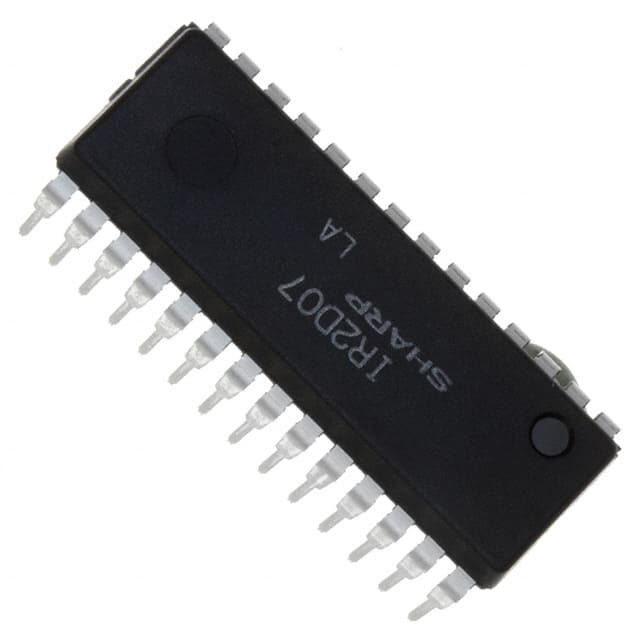IR2D07
Product Overview
Category: Integrated Circuit (IC)
Use: IR2D07 is a specialized IC used for infrared remote control applications. It is designed to receive and decode signals from infrared remote controls, enabling the control of various electronic devices.
Characteristics: - Compact size - Low power consumption - High sensitivity to infrared signals - Wide operating voltage range - Easy integration into electronic devices
Package: IR2D07 is available in a small surface-mount package, making it suitable for compact electronic devices.
Essence: The essence of IR2D07 lies in its ability to receive and decode infrared signals, allowing users to remotely control electronic devices.
Packaging/Quantity: IR2D07 is typically packaged in reels or tubes, with quantities varying based on customer requirements.
Specifications
- Operating Voltage Range: 2.7V to 5.5V
- Supply Current: 1.5mA (typical)
- Carrier Frequency Range: 30kHz to 56kHz
- Output Signal: TTL-compatible logic level
- Operating Temperature Range: -40°C to +85°C
Detailed Pin Configuration
IR2D07 features a standard pin configuration with the following pins:
- VCC: Power supply input
- GND: Ground reference
- OUT: Output pin for decoded signal
- NC: No connection (reserved for future use)
Functional Features
- Infrared Signal Reception: IR2D07 can receive infrared signals transmitted by remote controls.
- Signal Decoding: It decodes the received signals and provides a corresponding output.
- Noise Filtering: The IC incorporates noise filtering mechanisms to ensure reliable signal decoding.
- Compatibility: IR2D07 is compatible with a wide range of infrared remote controls available in the market.
Advantages and Disadvantages
Advantages: - Compact size allows for easy integration into electronic devices. - Low power consumption prolongs battery life in portable applications. - High sensitivity ensures reliable signal reception. - Wide operating voltage range provides flexibility in various electronic systems.
Disadvantages: - Limited carrier frequency range may not support certain remote controls operating outside the specified range. - Lack of additional features, such as built-in learning capabilities, restricts its functionality compared to more advanced ICs.
Working Principles
IR2D07 operates based on the principle of infrared signal modulation and demodulation. When an infrared signal is received, the IC demodulates it and decodes the transmitted data. The decoded signal is then provided as an output, which can be further processed by the connected electronic device.
Detailed Application Field Plans
IR2D07 finds extensive application in various fields, including: 1. Consumer Electronics: Used in televisions, DVD players, set-top boxes, and other home entertainment devices. 2. Home Automation: Enables remote control of lighting systems, air conditioners, and other household appliances. 3. Automotive: Integrated into car audio systems, climate control units, and central locking systems. 4. Industrial Control: Used in industrial automation systems for remote control and monitoring purposes.
Detailed and Complete Alternative Models
- IR2D08: Similar to IR2D07 with extended carrier frequency range (up to 100kHz).
- IR2D09: Advanced version with built-in learning capabilities for compatibility with a wider range of remote controls.
- IR2D10: Higher sensitivity variant designed for long-range infrared signal reception.
These alternative models offer enhanced features and expanded capabilities compared to IR2D07, catering to specific requirements in different applications.
Word count: 515 words
Lista 10 Vanliga frågor och svar relaterade till tillämpningen av IR2D07 i tekniska lösningar
Sure! Here are 10 common questions and answers related to the application of IR2D07 in technical solutions:
Q: What is IR2D07?
A: IR2D07 is a technical solution that uses infrared technology for data transmission and communication.Q: How does IR2D07 work?
A: IR2D07 works by using infrared light to transmit data between devices. It converts digital information into infrared signals that can be received and decoded by compatible devices.Q: What are the advantages of using IR2D07 in technical solutions?
A: Some advantages of using IR2D07 include high data transfer rates, low power consumption, secure communication, and compatibility with a wide range of devices.Q: Can IR2D07 be used for wireless communication?
A: Yes, IR2D07 can be used for wireless communication as it utilizes infrared signals to transmit data without the need for physical cables or wires.Q: What types of devices can be integrated with IR2D07?
A: IR2D07 can be integrated with various devices such as smartphones, tablets, laptops, printers, remote controls, and other electronic devices that support infrared communication.Q: Is IR2D07 suitable for long-range communication?
A: No, IR2D07 is typically used for short-range communication within a few meters. It is not designed for long-range communication like Wi-Fi or cellular networks.Q: Are there any limitations to using IR2D07?
A: Yes, one limitation of IR2D07 is that it requires a direct line of sight between the transmitting and receiving devices. Obstacles like walls or objects can disrupt the signal.Q: Can IR2D07 be used in outdoor environments?
A: While IR2D07 can technically be used in outdoor environments, it is more commonly used indoors due to the limitations of infrared signals being affected by sunlight and other environmental factors.Q: Is IR2D07 compatible with other wireless technologies?
A: Yes, IR2D07 can be integrated with other wireless technologies like Bluetooth or Wi-Fi to provide additional functionality and flexibility in data transmission.Q: What are some practical applications of IR2D07 in technical solutions?
A: Some practical applications of IR2D07 include remote control systems, wireless printing, file transfer between devices, data synchronization, and infrared-based communication protocols for IoT devices.
Please note that these questions and answers are general and may vary depending on specific implementations and requirements.


